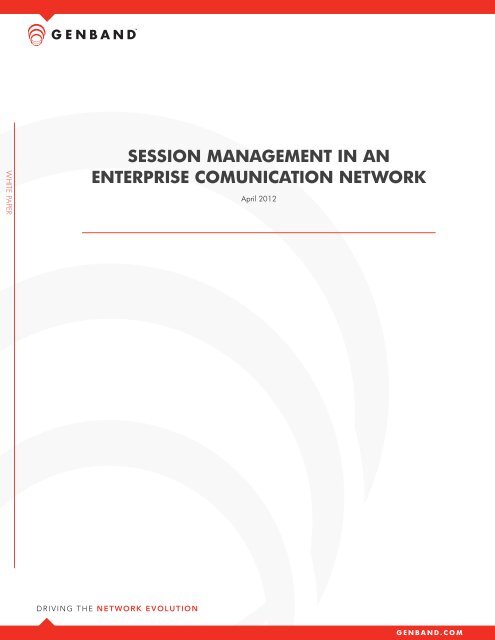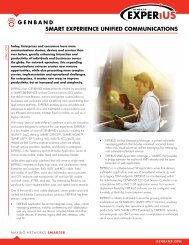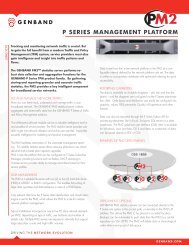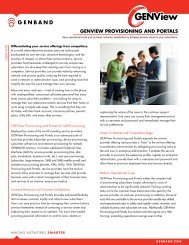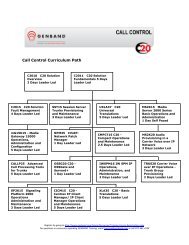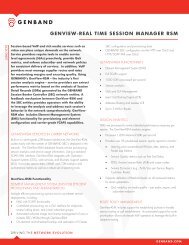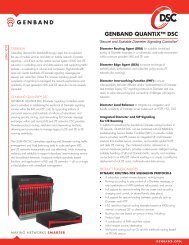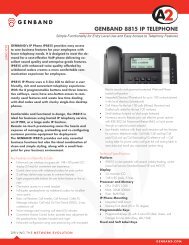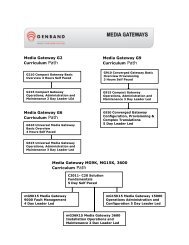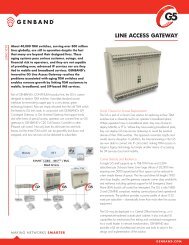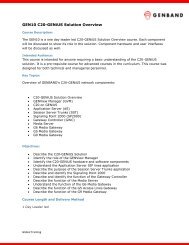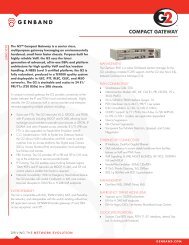session management in an enterprise comunication ... - Genband
session management in an enterprise comunication ... - Genband
session management in an enterprise comunication ... - Genband
You also want an ePaper? Increase the reach of your titles
YUMPU automatically turns print PDFs into web optimized ePapers that Google loves.
SESSION MANAGEMENT IN AN<br />
ENTERPRISE COMUNICATION NETWORK<br />
April 2012
SESSION MANAGEMENT IN AN ENTERPRISE COMUNICATION NETWORK<br />
Table of Contents<br />
Session M<strong>an</strong>agement <strong>in</strong> <strong>an</strong> Enterprise Communication Network...................... 1<br />
Introduction................................................................................................................. 3<br />
Session M<strong>an</strong>agement Challenges................................................................................... 3<br />
GENBAND Session M<strong>an</strong>agement Solution...................................................................... 4<br />
GENiUS IMS VoLTE Solution.......................................................................................... 5<br />
GENBAND Real Time Session M<strong>an</strong>agement (RSM)........................................................... 7<br />
Summary.................................................................................................................... 10<br />
2
SESSION MANAGEMENT IN AN ENTERPRISE COMUNICATION NETWORK<br />
Introduction<br />
Enterprise Chief Information Officers (CIOs) are <strong>in</strong>creas<strong>in</strong>gly<br />
aware that grow<strong>in</strong>g dem<strong>an</strong>d for <strong>in</strong>formation <strong>an</strong>d collaboration<br />
at <strong>an</strong>ytime, from <strong>an</strong>ywhere is plac<strong>in</strong>g enormous burden<br />
on network <strong>in</strong>frastructure. What was once a secure voice<br />
network is now becom<strong>in</strong>g a converged voice/data network<br />
support<strong>in</strong>g multiple IP <strong>in</strong>terfaces <strong>an</strong>d services. CIOs are<br />
pushed to their limits when confronted with questions such as:<br />
• How to support a multi-vendor network <strong>an</strong>d guar<strong>an</strong>tee<br />
<strong>in</strong>teroperability<br />
• How to securely convert their exist<strong>in</strong>g public voice access<br />
from costly PRI trunks to <strong>in</strong>expensive IP trunks<br />
• How to guar<strong>an</strong>tee quality voice, video <strong>an</strong>d multimedia<br />
services on a common IP <strong>in</strong>frastructure<br />
• How to <strong>in</strong>troduce new SIP services <strong>in</strong>to the network without<br />
affect<strong>in</strong>g exist<strong>in</strong>g <strong>in</strong>frastructure<br />
• How to meet import<strong>an</strong>t E911 <strong>an</strong>d CALEA requirements<br />
with the new VoIP network<br />
Enterprises need to harness the flexibility of the converged<br />
IP network to deliver voice <strong>an</strong>d multimedia services but must<br />
do so without creat<strong>in</strong>g complex overlays for each specific<br />
service. Such convergence naturally br<strong>in</strong>gs to the forefront<br />
challenges of ensur<strong>in</strong>g network security <strong>an</strong>d service visibility.<br />
Clear demarcation of <strong>enterprise</strong> <strong>an</strong>d service provider<br />
networks is m<strong>an</strong>datory to m<strong>an</strong>age services across the demarcation<br />
<strong>an</strong>d account<strong>in</strong>g for resource usage. The need for<br />
visibility <strong>in</strong>to the behavior of the network, the user, <strong>an</strong>d the<br />
perform<strong>an</strong>ce of the services carried over a converged IP <strong>in</strong>frastructure<br />
supersedes traditional Time Division Multiplex (TDM)<br />
network <strong>m<strong>an</strong>agement</strong> approaches. The emphasis becomes<br />
more on ga<strong>in</strong><strong>in</strong>g visibility <strong>an</strong>d control over the <strong>in</strong>dividual<br />
multimedia <strong>session</strong>s that ride over the IP <strong>in</strong>frastructure.<br />
While IP networks provide m<strong>an</strong>y capabilities to def<strong>in</strong>e Virtual<br />
Private Networks (VPNs) <strong>an</strong>d prioritize different multimedia<br />
traffic, they are not designed to be <strong>session</strong>-aware <strong>an</strong>d they<br />
provide few capabilities to m<strong>an</strong>age <strong>an</strong>d control end-user<br />
<strong>session</strong>s; a <strong>session</strong> be<strong>in</strong>g the IP-equivalent of a phone call. To<br />
illustrate this key po<strong>in</strong>t, m<strong>an</strong>y times users compla<strong>in</strong> about call<br />
quality across a voice over IP (VoIP) <strong>enterprise</strong> network while<br />
the IP/MPLS network layer is work<strong>in</strong>g properly. This is a void<br />
<strong>in</strong> current IP network solutions <strong>an</strong>d has the potential to impact<br />
converged IP-PBX <strong>in</strong>stallations.<br />
GENBAND’s <strong>session</strong> <strong>m<strong>an</strong>agement</strong> solution complements<br />
<strong>enterprise</strong> routers, switches, IP PBXs <strong>an</strong>d application servers,<br />
deliver<strong>in</strong>g the <strong>in</strong>formation <strong>an</strong>d control necessary to guar<strong>an</strong>tee<br />
quality <strong>session</strong>s <strong>an</strong>d services while customers realize both operational<br />
<strong>an</strong>d capital expense sav<strong>in</strong>gs. This paper discusses<br />
GENBAND’s unique approach to <strong>session</strong> <strong>m<strong>an</strong>agement</strong> that<br />
enables <strong>enterprise</strong>s to set up, secure, monitor, m<strong>an</strong>age <strong>an</strong>d<br />
account for IP-based <strong>session</strong>s, both Session Initiated Protocol<br />
(SIP) <strong>an</strong>d H.323.<br />
GENBAND’s solution enables network adm<strong>in</strong>istrators to<br />
• Establish Public Switched Telephone Network (PSTN)<br />
like the gr<strong>an</strong>ular control required for centralized <strong>session</strong><br />
<strong>m<strong>an</strong>agement</strong>, monitor<strong>in</strong>g <strong>an</strong>d account<strong>in</strong>g <strong>in</strong> a highly<br />
distributed converged IP network<br />
• Architect real-time dynamic policy based control of the<br />
end-to-end perform<strong>an</strong>ce of each <strong>session</strong><br />
• Flexibly meet <strong>enterprise</strong> service requirements without<br />
build<strong>in</strong>g separate overlay networks<br />
• Cost-effectively operate a converged communication<br />
network for the delivery of real-time IP services<br />
Session M<strong>an</strong>agement Challenges<br />
In the converged rich-media <strong>enterprise</strong>, service support requires<br />
traffic <strong>m<strong>an</strong>agement</strong> on a <strong>session</strong>-by-<strong>session</strong><br />
basis. Unlike the PSTN, which offers predictable resource<br />
utilization <strong>an</strong>d guar<strong>an</strong>teed service levels, the IP network is<br />
<strong>in</strong>herently a multi-service <strong>an</strong>d best-effort network. A new approach<br />
is required to derive PSTN-like controls <strong>an</strong>d real-time<br />
service predictability. The IP-layer offers Quality of Service<br />
(QOS) <strong>an</strong>d security features such as VLAN tagg<strong>in</strong>g <strong>an</strong>d<br />
MPLS. However, even with these lower layer features, <strong>session</strong><br />
quality is not guar<strong>an</strong>teed nor reported on <strong>an</strong> <strong>in</strong>dividual<br />
<strong>session</strong> basis; voice quality of a VoIP <strong>session</strong> may be poor<br />
while the IP layer is work<strong>in</strong>g properly. This problem is more<br />
apparent as IP <strong>session</strong>s travel outside the <strong>enterprise</strong> via direct<br />
IP trunks to the service provider. While service providers<br />
may provide Service Level Agreements (SLA) with<strong>in</strong> their own<br />
network, SLAs are difficult to guar<strong>an</strong>tee as <strong>session</strong>s traverse<br />
multiple <strong>an</strong>d worldwide IP networks. Network adm<strong>in</strong>istrators<br />
require added <strong>session</strong> specific control <strong>an</strong>d <strong>in</strong>telligence that<br />
3
SESSION MANAGEMENT IN AN ENTERPRISE COMUNICATION NETWORK<br />
allow them the follow<strong>in</strong>g:<br />
1. Dynamic control over the network h<strong>an</strong>dl<strong>in</strong>g of <strong>session</strong>s<br />
2. The ability to tailor the <strong>session</strong> support based on both<br />
bus<strong>in</strong>ess <strong>an</strong>d network constra<strong>in</strong>ts, <strong>an</strong>d<br />
3. The real-time end-to-end visibility of the <strong>session</strong>s, service<br />
<strong>an</strong>d network behaviors for usage account<strong>in</strong>g, SLA confirmation,<br />
bus<strong>in</strong>ess cont<strong>in</strong>uity <strong>an</strong>d capacity pl<strong>an</strong>n<strong>in</strong>g<br />
The network adm<strong>in</strong>istrator’s job is complicated by the distribution<br />
of network <strong>in</strong>telligence throughout the IP network <strong>an</strong>d<br />
the <strong>in</strong>troduction of a wide variety of network elements support<strong>in</strong>g<br />
adv<strong>an</strong>ced IP services. Adm<strong>in</strong>istrators need a different<br />
<strong>session</strong>-based approach that gives them PSTN-like control<br />
<strong>an</strong>d defuses the complexity of deliver<strong>in</strong>g real-time services<br />
with<strong>in</strong> a converged IP network.<br />
GENBAND provides a <strong>session</strong> <strong>m<strong>an</strong>agement</strong> solution that was<br />
purpose-built to address these issues <strong>an</strong>d give network adm<strong>in</strong>istrators<br />
the tools <strong>an</strong>d statistics necessary to control service<br />
delivery at the <strong>session</strong> layer. This system solution consists of<br />
two components: (1) Session Border Controller (SBC) <strong>an</strong>d<br />
(3) Real-Time Session M<strong>an</strong>ager (RSM). Work<strong>in</strong>g together,<br />
these products provide the authoritative network probe po<strong>in</strong>ts<br />
<strong>an</strong>d <strong>an</strong>alytics to (1) collect <strong>an</strong>d report <strong>session</strong> statistics, (2)<br />
<strong>an</strong>alyze the <strong>session</strong> statistics <strong>in</strong> real-time, <strong>an</strong>d (3) act on the<br />
<strong>an</strong>alysis results so that <strong>session</strong>s cont<strong>in</strong>ue to meet user-def<strong>in</strong>ed<br />
quality metrics. The next section discusses GENBAND products<br />
<strong>an</strong>d <strong>session</strong> <strong>m<strong>an</strong>agement</strong> <strong>in</strong> further detail.<br />
GENBAND Session M<strong>an</strong>agement Solution<br />
GENBAND products are architected along three wellestablished<br />
network layers loosely match<strong>in</strong>g layers 3, 5,<br />
<strong>an</strong>d 7 of the OSI stack (refer to figure 1). This architecture<br />
results <strong>in</strong> flexible software products that separate signal<strong>in</strong>g<br />
from media, products that c<strong>an</strong> be packaged <strong>in</strong> different ways<br />
depend<strong>in</strong>g on customer needs <strong>an</strong>d products that meet new<br />
IMS concepts.<br />
At layer 3, correspond<strong>in</strong>g to the tr<strong>an</strong>sport layer, is the GEN-<br />
BAND S3 SBC. The SBC provides IP security functionality<br />
while process<strong>in</strong>g both signal<strong>in</strong>g <strong>an</strong>d media. These features<br />
<strong>in</strong>clude the follow<strong>in</strong>g:<br />
Figure 1 – The GENBAND S-Series is a family of <strong>session</strong> oriented products<br />
each targeted to h<strong>an</strong>dle specific areas of <strong>session</strong>-based service delivery <strong>an</strong>d<br />
<strong>m<strong>an</strong>agement</strong><br />
Signal<strong>in</strong>g features:<br />
SIP Signal<strong>in</strong>g: Voice, Video, IP BPX Trunk<strong>in</strong>g, SIP/H.323 Interwork<strong>in</strong>g<br />
function, Rout<strong>in</strong>g/Hunt<strong>in</strong>g, Call Admission Control,<br />
SLA Policy Enforcement<br />
Security features:<br />
VoIP Firewall, NAT, NAT Traversal, DoS Protection, Topology<br />
Hid<strong>in</strong>g<br />
Media features:<br />
VLAN Tagg<strong>in</strong>g, 802.1p/q, QoS, •diffserve<br />
Selective media rout<strong>in</strong>g with optional tr<strong>an</strong>scod<strong>in</strong>g<br />
Regulatory features:<br />
E911 emergency services, Legal Intercept<br />
The GENBAND S3 SBC is also a network probe po<strong>in</strong>t that<br />
collects per-<strong>session</strong> data such as packet delay, jitter, <strong>an</strong>d<br />
lost packets. It also calculates Me<strong>an</strong> Op<strong>in</strong>ion Score (MOS)<br />
per <strong>session</strong>, report<strong>in</strong>g this <strong>in</strong>formation <strong>in</strong> per-<strong>session</strong> Session<br />
Detail Records (SDRs). Per-<strong>session</strong> SDRs are unique <strong>in</strong> the <strong>in</strong>dustry<br />
<strong>an</strong>d one of the core components of <strong>in</strong>telligent <strong>session</strong><br />
<strong>m<strong>an</strong>agement</strong>.<br />
Next, at layer 5, the GENBAND S3 SBC provides <strong>an</strong> endto-end<br />
view of the <strong>session</strong>. With <strong>an</strong> <strong>in</strong>tegrated SIP Proxy <strong>an</strong>d<br />
H.323 gatekeeper, the SBC performs registration <strong>an</strong>d global<br />
<strong>session</strong> rout<strong>in</strong>g from IP-PBX to SBC <strong>an</strong>d between IP-PBXs.<br />
4
SESSION MANAGEMENT IN AN ENTERPRISE COMUNICATION NETWORK<br />
However, different th<strong>an</strong> a basic SIP proxy or Gatekeeper, the<br />
S3 SBC supports a multitude of enh<strong>an</strong>ced rout<strong>in</strong>g <strong>an</strong>d hunt<strong>in</strong>g<br />
features that give network adm<strong>in</strong>istrators superior control<br />
of IP <strong>session</strong>s. Some of those features <strong>in</strong>clude:<br />
M<strong>an</strong>y of these features offered by GENBAND are unique <strong>in</strong><br />
the <strong>in</strong>dustry. The S3 SBC is also used as a probe po<strong>in</strong>t to<br />
generate SDRs conta<strong>in</strong><strong>in</strong>g <strong>session</strong> statistics such as <strong>session</strong> call<br />
hold times <strong>an</strong>d post dial delay times.<br />
Rout<strong>in</strong>g Eng<strong>in</strong>e features:<br />
• Port <strong>an</strong>d Trunk Group level gr<strong>an</strong>ularity for rout<strong>in</strong>g allows<br />
the establishment of rout<strong>in</strong>g policies on <strong>an</strong> endpo<strong>in</strong>t<br />
basis down to the port level or Trunk Group level<br />
• Flexible policy enforcement c<strong>an</strong> be applied for both<br />
<strong>in</strong>com<strong>in</strong>g <strong>an</strong>d outgo<strong>in</strong>g calls<br />
• GENBAND call<strong>in</strong>g pl<strong>an</strong>s facilitate a large variety of rout<strong>in</strong>g<br />
policies <strong>in</strong>clud<strong>in</strong>g time of day rout<strong>in</strong>g, route priority<br />
by route or endpo<strong>in</strong>t <strong>an</strong>d route hunt<strong>in</strong>g<br />
• Sophisticated call treatment of the called <strong>an</strong>d call<strong>in</strong>g<br />
numbers enables applications such as permissive dial<strong>in</strong>g<br />
<strong>an</strong>d adapt call requests to the unique requirements of<br />
term<strong>in</strong>at<strong>in</strong>g gateways<br />
• Support for over 2 million routes per system<br />
• Comprehensive SDRs that capture over n<strong>in</strong>ety (90) per<br />
<strong>session</strong> perform<strong>an</strong>ce statistics<br />
Dynamic Call Hunt<strong>in</strong>g features<br />
• On a failed egress call attempt, the next dest<strong>in</strong>ation<br />
endpo<strong>in</strong>t to be selected is one which is the best of the<br />
rema<strong>in</strong><strong>in</strong>g set of endpo<strong>in</strong>ts which c<strong>an</strong> route that call.<br />
• Up to 16 route hunts or route adv<strong>an</strong>ces c<strong>an</strong> be set up on<br />
the system.<br />
• Call hunt<strong>in</strong>g is enabled globally for the system or on<br />
a per source endpo<strong>in</strong>t basis. The configuration on the<br />
source endpo<strong>in</strong>t overrides the global system sett<strong>in</strong>g.<br />
• Call hunt<strong>in</strong>g is dynamically disabled whenever the dest<strong>in</strong>ation<br />
endpo<strong>in</strong>t sends media <strong>in</strong> its Progress Message<br />
<strong>in</strong>dication.<br />
• Both SIP <strong>an</strong>d H.323 calls are subject to hunt<strong>in</strong>g. Whenever<br />
the S3 SBC forwards media, hunt<strong>in</strong>g is disabled for<br />
that call. Every route hunt generates a SDR. The SDRs<br />
are l<strong>in</strong>ked by a common callid.<br />
• The S3 SBC is compli<strong>an</strong>t with the Internet Draft on SIP to<br />
ISDN/Q.931 release cause mapp<strong>in</strong>gs.<br />
F<strong>in</strong>ally, there is the application layer <strong>session</strong> m<strong>an</strong>ager known<br />
as the GENView RSM. The RSM collects statistics from the<br />
SBC(s), for example packet delays, jitter, lost packets, MOS<br />
score, <strong>session</strong> call hold times, post dial delay times, <strong>an</strong>d<br />
malformed SIP message statistics. The RSM pulls these statistics<br />
from SDRs <strong>an</strong>d first reports them to the network operator to<br />
help them m<strong>an</strong>age their network. Second, the RSM <strong>an</strong>alyzes<br />
the data aga<strong>in</strong>st metrics def<strong>in</strong>ed per subscriber, per <strong>session</strong><br />
<strong>an</strong>d per application to determ<strong>in</strong>e if there are network problems,<br />
for example MOS metrics drop below acceptable levels<br />
or call duration drops below thresholds - both <strong>in</strong>dicators that<br />
there are <strong>session</strong> problems. Third, if problems are found, the<br />
RSM immediately notifies <strong>an</strong> operator via email or page.<br />
F<strong>in</strong>ally, the GENView RSM will automatically correct problems<br />
by generat<strong>in</strong>g new route paths <strong>an</strong>d updat<strong>in</strong>g SBCs with the<br />
new policy<br />
<strong>in</strong>formation. This patent-pend<strong>in</strong>g feedback loop, known as the<br />
Dynamic Policy M<strong>an</strong>agement (DPM), between the RSM <strong>an</strong>d<br />
the SBCs completes the <strong>session</strong> <strong>m<strong>an</strong>agement</strong> solution; the RSM<br />
capitalizes on the SBC <strong>session</strong> <strong>in</strong>sight to dynamically control<br />
<strong>session</strong>s depend<strong>in</strong>g upon current network conditions.<br />
GENiUS IMS VoLTE Solution<br />
The GENBAND <strong>in</strong>telligent <strong>session</strong> <strong>m<strong>an</strong>agement</strong> system complements<br />
other IP-PBX offer<strong>in</strong>gs by address<strong>in</strong>g, for example,<br />
multi-vendor issues, multi-protocol issues, QoS, security, <strong>an</strong>d<br />
reliability concerns. Figure 2 depicts a typical large distributed<br />
IP-based <strong>enterprise</strong> communication network consist<strong>in</strong>g<br />
of IP-PBXs from multiple vendors, both TDM <strong>an</strong>d IP gateways<br />
to thes service provider <strong>an</strong>d multiple IP- based applications<br />
such as conferenc<strong>in</strong>g <strong>an</strong>d unified messag<strong>in</strong>g. Also <strong>in</strong>cluded<br />
are GENBAND <strong>session</strong> <strong>m<strong>an</strong>agement</strong> components <strong>in</strong>clud<strong>in</strong>g a<br />
st<strong>an</strong>dalone SBC, collocated SBC <strong>an</strong>d a RSM:<br />
5
SESSION MANAGEMENT IN AN ENTERPRISE COMUNICATION NETWORK<br />
later matched to SLA commitments by the service provider. In<br />
addition, the S3 SBC c<strong>an</strong> be configured to trickle calls back<br />
through SIP Trunk 1 until QOS is improved at which time it<br />
will switch back to normal static rout<strong>in</strong>g rules. All of these actions<br />
are automatic <strong>an</strong>d controlled by user-configured policies.<br />
It is a simple example but it presents the basics of <strong>in</strong>telligent<br />
<strong>session</strong> <strong>m<strong>an</strong>agement</strong> <strong>an</strong>d differentiation offered with the<br />
GENBAND solution. M<strong>an</strong>y service provider <strong>an</strong>d <strong>enterprise</strong><br />
customers have already beg<strong>an</strong> implement<strong>in</strong>g a <strong>session</strong><br />
<strong>m<strong>an</strong>agement</strong> system <strong>an</strong>d are report<strong>in</strong>g numerous benefits<br />
both <strong>in</strong>side the <strong>enterprise</strong> <strong>an</strong>d between <strong>enterprise</strong> <strong>an</strong>d service<br />
provider. Some of these benefits are listed below:<br />
Figure 2 - GENBAND S-Series SBC Solution Offer<strong>in</strong>g<br />
The st<strong>an</strong>dalone S3 SBC delivers <strong>in</strong>dustry-lead<strong>in</strong>g functionality,<br />
hav<strong>in</strong>g been awarded security <strong>an</strong>d feature awards from<br />
several <strong>in</strong>dependent test houses <strong>in</strong>clud<strong>in</strong>g Network World’s<br />
Clear Choice Award. Even further value is delivered when the<br />
SBC adv<strong>an</strong>ced rout<strong>in</strong>g capabilities <strong>an</strong>d <strong>session</strong> <strong>m<strong>an</strong>agement</strong><br />
capabilities of the RSM are <strong>in</strong>troduced. The example illustrates<br />
how GENBAND components provide direct IP connectivity<br />
between the <strong>enterprise</strong>s, consumers, <strong>an</strong>d VoIP service<br />
providers via SIP or H.323 trunk<strong>in</strong>g.<br />
Session M<strong>an</strong>agement Example: Assume the <strong>enterprise</strong><br />
<strong>in</strong> Figure 2 has configured the SBC so that time-of-day policy,<br />
location-based policy <strong>an</strong>d least cost rout<strong>in</strong>g policy dictates<br />
to use SIP Trunk 1 for all outgo<strong>in</strong>g calls. VoIP <strong>session</strong>s will be<br />
completed through the GENBAND S3 SBC <strong>an</strong>d statistics are<br />
collected after each call. Suddenly, calls through SIP Trunk<br />
1 receive low MOS scores <strong>in</strong>dicat<strong>in</strong>g a quality of service<br />
challenge deep with<strong>in</strong> the service provider’s network. This<br />
results <strong>in</strong> user compla<strong>in</strong>ts <strong>an</strong>d potentially lost revenue. With<br />
GENBAND’s <strong>session</strong> <strong>m<strong>an</strong>agement</strong> SBC <strong>an</strong>d the RSM <strong>an</strong>alytics,<br />
this condition is identified very quickly by the RSM, which<br />
triggers several events. First, it notifies the SBC to override<br />
static rout<strong>in</strong>g rules so that future <strong>session</strong>s are routed to the<br />
alternate SIP Trunk 2 - result<strong>in</strong>g <strong>in</strong> higher call completions<br />
<strong>an</strong>d fewer compla<strong>in</strong>ts. Second, the RSM notifies network<br />
operations personnel via email or phone that a problem has<br />
been encountered. Third, it generates reports that c<strong>an</strong> be<br />
Session <strong>m<strong>an</strong>agement</strong> benefits with<strong>in</strong> the <strong>enterprise</strong><br />
• Centralized <strong>in</strong>ter-PBX dial pl<strong>an</strong> <strong>m<strong>an</strong>agement</strong><br />
• Multi-vendor IP-PBX <strong>in</strong>teroperability<br />
• SIP <strong>an</strong>d H.323 protocol <strong>in</strong>terwork<strong>in</strong>g<br />
• SDR aggregation<br />
• Proactive voice quality monitor<strong>in</strong>g / report<strong>in</strong>g / notification<br />
• Least cost rout<strong>in</strong>g for <strong>in</strong>tra-<strong>enterprise</strong> call<strong>in</strong>g (on-net<br />
versus <strong>in</strong>tra-state versus <strong>in</strong>ter-state)<br />
• Policy decision-based rout<strong>in</strong>g – LCR Override<br />
• Centralized Call Admission Control<br />
Session <strong>m<strong>an</strong>agement</strong> benefits between <strong>enterprise</strong><br />
<strong>an</strong>d service provider:<br />
• End-to-end SLA quality assur<strong>an</strong>ce<br />
• Least cost rout<strong>in</strong>g (multiple SP access <strong>an</strong>d multiple SPs)<br />
• Policy decision-based rout<strong>in</strong>g – LCR Override<br />
• Take-back <strong>an</strong>d tr<strong>an</strong>sfer with<strong>in</strong> the <strong>enterprise</strong>, carrier<br />
agnostic<br />
• Protocol <strong>in</strong>terwork<strong>in</strong>g (SIP to H.323) between service<br />
provider <strong>an</strong>d <strong>enterprise</strong><br />
• SIP normalization between service providers<br />
• Secure network edge, especially for carrier provided<br />
VPN<br />
These same customers are report<strong>in</strong>g signific<strong>an</strong>t operational<br />
<strong>an</strong>d capital expenditure benefits when add<strong>in</strong>g <strong>session</strong><br />
<strong>m<strong>an</strong>agement</strong> to their IP-BPX <strong>enterprise</strong>. Some of the sav<strong>in</strong>gs<br />
<strong>in</strong>clude the follow<strong>in</strong>g:<br />
6
SESSION MANAGEMENT IN AN ENTERPRISE COMUNICATION NETWORK<br />
Operation Expenditure Benefits:<br />
• Enables lower carrier access <strong>an</strong>d feature rates<br />
• Network-wide least cost rout<strong>in</strong>g reduces telephony<br />
expenses<br />
• Provides evidence for SLAs with service provider (loss<br />
recovery)<br />
• Reduces labor required to support configuration <strong>an</strong>d<br />
ma<strong>in</strong>ten<strong>an</strong>ce of dial pl<strong>an</strong>s across PBXs<br />
• Reduces cost of SDR collection/aggregation<br />
• Enables carrier bypass through <strong>enterprise</strong>-to-<strong>enterprise</strong><br />
VoIP peer<strong>in</strong>g<br />
Capital Expenditure Benefits:<br />
• Leverages exist<strong>in</strong>g <strong>in</strong>vestments through protocol <strong>an</strong>d<br />
vendor <strong>in</strong>terwork<strong>in</strong>g<br />
• Avoids over-provision<strong>in</strong>g to ensure network supports realtime<br />
data<br />
As previously discussed, GENBAND’s <strong>in</strong>telligent <strong>session</strong> <strong>m<strong>an</strong>agement</strong><br />
system complements IP-PBX offer<strong>in</strong>gs <strong>an</strong>d delivers<br />
signific<strong>an</strong>t customer benefits that are unique <strong>in</strong> the <strong>in</strong>dustry.<br />
Session <strong>m<strong>an</strong>agement</strong> differentiates <strong>an</strong> <strong>enterprise</strong> bid from<br />
competitive bids.<br />
GENView Real-Time Session M<strong>an</strong>agement (RSM)<br />
The GENView RSM complements the GENBAND S3 SBC by<br />
provid<strong>in</strong>g automatic feedback of network behavior, SLA or<br />
threshold check<strong>in</strong>g <strong>an</strong>d the dynamic adjustment of <strong>session</strong><br />
devices <strong>an</strong>d <strong>in</strong>terconnects. The feedback provides <strong>enterprise</strong>s<br />
with a highly predictive, scalable service architecture for <strong>session</strong><br />
based applications. In addition, the RSM is designed to<br />
provide the network adm<strong>in</strong>istrators with a s<strong>in</strong>gle po<strong>in</strong>t from<br />
which they control <strong>an</strong>d assess the perform<strong>an</strong>ce of <strong>session</strong>s<br />
travers<strong>in</strong>g the GENBAND SBC.<br />
RSM Architecture<br />
The RSM runs on a st<strong>an</strong>dards-based Intel hardware platform<br />
host<strong>in</strong>g a carrier-grade L<strong>in</strong>ux-based operat<strong>in</strong>g system. The<br />
GENView RSM architecture is illustrated <strong>in</strong> Figure 3. The RSM<br />
<strong>an</strong>d SBC run on separate hardware platforms.<br />
An RSM Agent component runs on the SBC platform, which<br />
provides the required <strong>in</strong>formation <strong>an</strong>d <strong>in</strong>terface to the RSM.<br />
The RSM Agent implements several logical modules <strong>in</strong>clud<strong>in</strong>g<br />
Figure 3 - Architecture illustrates the <strong>in</strong>teraction between the GENBAND<br />
Real-time SessionM<strong>an</strong>ager (RSM) <strong>an</strong>d the S-Series SBC<br />
the SDR server, J server Interface <strong>an</strong>d logPP <strong>in</strong> the SBC. The<br />
SDR server reads the SDRS files created by the SBC <strong>an</strong>d<br />
delivers them to the RSM server us<strong>in</strong>g st<strong>an</strong>dard HTTP or<br />
HTTPS. The delivery of SDRs is via POST mech<strong>an</strong>isms with<br />
up to 2500 SDRs per second supported. Optionally, the SBC<br />
c<strong>an</strong> be configured to stream SDRs to third-party databases.<br />
Similarly, log files gathered at the SBC may be forwarded<br />
to the RSM server us<strong>in</strong>g logPP agent component, for further<br />
<strong>an</strong>alysis. This enables service operators to react to alarms<br />
<strong>an</strong>d events <strong>in</strong>dicat<strong>in</strong>g threshold cross<strong>in</strong>gs <strong>in</strong> either the <strong>session</strong><br />
perform<strong>an</strong>ce or health of the <strong>session</strong> elements. The RSM may<br />
be set up to dynamically update route tables at the SBC when<br />
react<strong>in</strong>g to <strong>session</strong> status <strong>an</strong>d health.<br />
The RSM is supported by a web-based RSM client. Additionally,<br />
the RSM web-services API provides northbound <strong>in</strong>terface<br />
for programmatic flow-through provision<strong>in</strong>g. Service operators<br />
<strong>an</strong>d NOC personnel c<strong>an</strong> use their browsers to remotely<br />
m<strong>an</strong>age the GENBAND entities or <strong>in</strong>tegrate with exist<strong>in</strong>g<br />
<strong>m<strong>an</strong>agement</strong> tools via the web services API.<br />
The GENBAND RSM supports these <strong>session</strong> <strong>m<strong>an</strong>agement</strong><br />
tasks:<br />
• Policy <strong>an</strong>d route <strong>m<strong>an</strong>agement</strong> for Call Admission Control<br />
(CAC)<br />
• Quality of Service <strong>an</strong>d Service Level M<strong>an</strong>agement<br />
• Service visibility <strong>an</strong>d perform<strong>an</strong>ce records<br />
7
SESSION MANAGEMENT IN AN ENTERPRISE COMUNICATION NETWORK<br />
• Alarms <strong>an</strong>d Events affect<strong>in</strong>g the service<br />
• Centralized Provision<strong>in</strong>g <strong>an</strong>d ma<strong>in</strong>ten<strong>an</strong>ce<br />
• Generat<strong>in</strong>g reports for bus<strong>in</strong>ess <strong>an</strong>d network pl<strong>an</strong>n<strong>in</strong>g<br />
tasks<br />
• SDR <strong>m<strong>an</strong>agement</strong><br />
The GENView RSM also <strong>in</strong>cludes the follow<strong>in</strong>g task-specific<br />
modules:<br />
• Route Analysis Module (RAM) – the RAM runn<strong>in</strong>g<br />
on the GENView RSM server processes SDRs <strong>in</strong> real-time<br />
from multiple SBC platforms <strong>an</strong>d is used to determ<strong>in</strong>e<br />
QoS. This is the fundamental component by which<br />
the RSM Agent communicates with the SBC. The RAM<br />
provides a basic set of eng<strong>in</strong>eer<strong>in</strong>g reports <strong>in</strong>clud<strong>in</strong>g the<br />
Answer Seizure Ratio (ASR), list<strong>in</strong>g of 200 most recent<br />
calls, <strong>an</strong>d enables custom reports to be specified.<br />
• Events <strong>an</strong>d Statistics Module (ESM) – the ESM<br />
facilitates alarm<strong>in</strong>g which c<strong>an</strong> be syslog based or SDR<br />
based. SBC log files are parsed for specific error codes<br />
to trigger alarms. Similarly, SDR <strong>in</strong>formation (e.g. error<br />
response, ASR threshold, total number of m<strong>in</strong>utes, etc.) is<br />
used to assess event <strong>an</strong>d alarm generation. Action taken<br />
<strong>in</strong>cludes logg<strong>in</strong>g the error to a file, generat<strong>in</strong>g <strong>an</strong> email<br />
to the network adm<strong>in</strong>istrator, or block<strong>in</strong>g a particular<br />
endpo<strong>in</strong>t via the Adaptive Rout<strong>in</strong>g Module.<br />
• Adaptive Rout<strong>in</strong>g Module (ARM) – the ARM<br />
provides a set of actions to ch<strong>an</strong>ge the route table configuration<br />
on the SBC. The ARM provides a mech<strong>an</strong>ism<br />
to disable calls at endpo<strong>in</strong>t <strong>in</strong>gress or egress based on<br />
alarm conditions <strong>an</strong>d network capacity states.<br />
• Bus<strong>in</strong>ess Analysis Module (BAM) – the BAM<br />
processes SDRs from the RSM database to produce ondem<strong>an</strong>d<br />
bus<strong>in</strong>ess reports. These <strong>in</strong>clude usage <strong>an</strong>d cost<br />
by route, sector, etc. The RSM provides hooks to external<br />
bill<strong>in</strong>g <strong>an</strong>d account<strong>in</strong>g systems via its Web Services<br />
(WSDL) <strong>in</strong>terface.<br />
• Web Interface Module (WIM) – the WIM provides<br />
user access via a web <strong>in</strong>terface for which the user is<br />
authorized. Subscribers may be set up with portal access<br />
for self-care purposes, controlled <strong>an</strong>d secure <strong>in</strong> their<br />
group or department. In cases where the RSM is shared<br />
between multiple groups, known as partition<strong>in</strong>g, the<br />
WIM restricts user views to their respective partitions.<br />
Note that there is no limit to the number of user per<br />
partition or number of access lists.<br />
• Least Cost Rout<strong>in</strong>g Module (LCR) – LCR generates<br />
rout<strong>in</strong>g rules based on BAM rat<strong>in</strong>g <strong>in</strong>formation. The LCRgenerated<br />
routes are then used to reconfigure the route<br />
tables <strong>in</strong> the SBC to effect the required ch<strong>an</strong>ges.<br />
• Third Party SDR Support Module (TCS) – the TCS<br />
enables import<strong>in</strong>g of third-party SDRs <strong>in</strong>to the RSM for<br />
report<strong>in</strong>g/rat<strong>in</strong>g <strong>an</strong>d export<strong>in</strong>g to third-party database<br />
directly from the RSM. Under partitioned conditions, only<br />
SDRs that belong to that partition are streamed.<br />
RSM Reports<br />
The reports generated by the GENView RSM enable network<br />
adm<strong>in</strong>istrators to monitor system activity <strong>in</strong> real-time for technical<br />
<strong>an</strong>d bus<strong>in</strong>ess purposes. Eng<strong>in</strong>eer<strong>in</strong>g reports display the ASR <strong>in</strong><br />
various formats, or a list of the last 200 calls c<strong>an</strong> be displayed.<br />
Up to 11 types of reports c<strong>an</strong> be generated which are colorcoded<br />
based upon ASR percentages, <strong>an</strong>d a graph generated<br />
of ASR aga<strong>in</strong>st time. Calls are grouped <strong>an</strong>d color-coded <strong>in</strong>to<br />
ab<strong>an</strong>doned, busy, error or normal status categories with each<br />
<strong>in</strong>dividual call <strong>an</strong>d detailed SDR <strong>in</strong>formation available. The<br />
report provides operational staff <strong>in</strong>sight <strong>in</strong>to network health <strong>an</strong>d<br />
the ability to <strong>an</strong>alyze issues on a call-by-call basis. Reports c<strong>an</strong><br />
also be filtered based upon parameters such as the SBC host<br />
platform, start date, end date, source ID <strong>an</strong>d dest<strong>in</strong>ation ID. The<br />
report c<strong>an</strong> be set to periodically update <strong>an</strong>d display via the<br />
web <strong>in</strong>terface. An example eng<strong>in</strong>eer<strong>in</strong>g report generated by the<br />
GENView RSM is highlighted below:<br />
Figure 4 - GENView RSM Eng<strong>in</strong>eer<strong>in</strong>g Report graphically presents the quality<br />
of the services <strong>an</strong>d other perform<strong>an</strong>ce metrics<br />
8
SESSION MANAGEMENT IN AN ENTERPRISE COMUNICATION NETWORK<br />
The RSM system c<strong>an</strong> also be used to generate up to 44<br />
unique bus<strong>in</strong>ess reports. This feature comprises11 filters such<br />
as Region, Customer, Supplier <strong>an</strong>d various source/dest<strong>in</strong>ation<br />
filters each of which support the follow<strong>in</strong>g four sort criteria:<br />
Calls, M<strong>in</strong>utes, Revenue <strong>an</strong>d Profit. An example bus<strong>in</strong>ess<br />
report generated by the GENView RSM is highlighted below:<br />
• Generate SNMP Trap – sends a SNMP with textual<br />
alarm name <strong>an</strong>d description to def<strong>in</strong>ed IP address<br />
• Block – c<strong>an</strong> be used to block all endpo<strong>in</strong>t calls or set a<br />
value to trickle calls<br />
• Modify Endpo<strong>in</strong>t Priority - c<strong>an</strong> be used to ch<strong>an</strong>ge the<br />
priority of <strong>an</strong> endpo<strong>in</strong>t<br />
• Modify Route Priority - c<strong>an</strong> be used to ch<strong>an</strong>ge the priority<br />
of a route<br />
• Execute Script – c<strong>an</strong> execute <strong>an</strong> external script file which<br />
c<strong>an</strong> be used to extend the RSM capabilities<br />
• Log – c<strong>an</strong> be used to log to Syslog or local file<br />
• Mail – establish which email addresses should receive<br />
specific subject-related emails<br />
• Unblock – this restores the max calls configuration to <strong>an</strong><br />
endpo<strong>in</strong>t<br />
Figure 5 - GENView RSM Bus<strong>in</strong>ess Report <strong>in</strong>cludes <strong>an</strong>alysis of the cost of carry<strong>in</strong>g<br />
the <strong>session</strong> to ensure the service operates with<strong>in</strong> the bus<strong>in</strong>ess<br />
specified constra<strong>in</strong>ts<br />
RSM Alarms<br />
The GENView RSM enables network adm<strong>in</strong>istrators to set<br />
specific conditions under which alarms are triggered <strong>an</strong>d def<strong>in</strong>e<br />
system behavior under these conditions. The RSM c<strong>an</strong> be<br />
configured to detect alarms from either system level log files<br />
of each SBC platform or from SDRs generated by them. The<br />
r<strong>an</strong>ge of SDR alarm types generated <strong>in</strong>clude parameters such<br />
as local disconnect, ASR, gateway m<strong>in</strong>utes, dollar amount,<br />
average request rate, average call duration, post dial delay,<br />
low voice quality, high packet loss <strong>an</strong>d jitter. All alarms c<strong>an</strong><br />
have two sets of actions assigned, the first set of actions, or<br />
ON-Trigger, are performed when the trigger condition is met,<br />
for example ASR < 50%. When the trigger condition is<br />
reset, e.g. ASR > 50%, the OFF-Trigger actions are performed.<br />
Alarms c<strong>an</strong> be based on time-of-day, system load,<br />
region, customer, supplier or endpo<strong>in</strong>t provid<strong>in</strong>g a flexible<br />
environment for event detection <strong>an</strong>d trigger<strong>in</strong>g. Alarms <strong>an</strong>d<br />
events may be associated with a r<strong>an</strong>ge of different actions,<br />
such as:<br />
Figure 6 - CDR, Log, <strong>an</strong>d SNMP Alarm View<strong>in</strong>g Example<br />
The alarm capabilities of the GENView RSM provide network<br />
adm<strong>in</strong>istrators with <strong>an</strong> end-to-end view <strong>in</strong>to network health,<br />
allow<strong>in</strong>g automation of responses to perform<strong>an</strong>ce ch<strong>an</strong>ges<br />
<strong>in</strong> the network. This enables adm<strong>in</strong>istrators to take corrective<br />
action for degradation <strong>in</strong> QoS thereby improv<strong>in</strong>g the overall<br />
user experience.<br />
RSM Provision<strong>in</strong>g<br />
The provision<strong>in</strong>g support <strong>in</strong>cluded <strong>in</strong> the RSM simplifies the<br />
<strong>m<strong>an</strong>agement</strong> of GENBAND endpo<strong>in</strong>ts, routes, call<strong>in</strong>g pl<strong>an</strong>s<br />
as well as rat<strong>in</strong>g <strong>in</strong>formation. For example, it enables <strong>an</strong><br />
adm<strong>in</strong>istrator to configure comprehensive rat<strong>in</strong>g <strong>in</strong>formation<br />
such as m<strong>in</strong>imum duration, bill<strong>in</strong>g <strong>in</strong>crement, <strong>an</strong>d connection<br />
charge, which c<strong>an</strong> be date/time activated allow<strong>in</strong>g mech<strong>an</strong>isms<br />
such as off-peak <strong>an</strong>d on-peak rates to be applied<br />
for a given route. This <strong>in</strong>formation c<strong>an</strong> be provisioned m<strong>an</strong>ually<br />
through the web <strong>in</strong>terface or by import<strong>in</strong>g <strong>an</strong> external<br />
file def<strong>in</strong><strong>in</strong>g the various data <strong>in</strong>to the RSM. Based upon this<br />
9
SESSION MANAGEMENT IN AN ENTERPRISE COMUNICATION NETWORK<br />
<strong>in</strong>formation the RSM rates SDRs for the specified regions/<br />
routes as they are received from the various GENBAND<br />
S-Series SBCs <strong>in</strong> the network.<br />
Us<strong>in</strong>g the provisioned rat<strong>in</strong>g <strong>in</strong>formation the GENView RSM<br />
generates a LCR report display<strong>in</strong>g routes prioritized by the<br />
order of least cost. The priority of routes c<strong>an</strong> be m<strong>an</strong>ually<br />
modified <strong>an</strong>d imported directly to the GENBAND SBC to<br />
update rout<strong>in</strong>g criteria with<strong>in</strong> the network. In<br />
addition the RSM system is also capable of generat<strong>in</strong>g Maximum<br />
Profit Rout<strong>in</strong>g (MPR) reports to determ<strong>in</strong>e which traffic<br />
routes generate the highest revenues.<br />
The GENBAND <strong>in</strong>telligent <strong>session</strong> <strong>m<strong>an</strong>agement</strong> system<br />
addresses key issues <strong>an</strong>d is coupled with the most comprehensive<br />
set of report<strong>in</strong>g capabilities available; the system<br />
provides a visibly differentiated approach to m<strong>an</strong>ag<strong>in</strong>g a<br />
converged network. This empowers the CIO <strong>an</strong>d IT group<br />
to deliver quality services to end-users <strong>an</strong>d enables them to<br />
<strong>in</strong>troduce new converged services that improve overall<br />
productivity.<br />
The GENBAND RSM also provides adm<strong>in</strong>istrators with the<br />
capability to partition the RSM <strong>an</strong>d SBC data <strong>in</strong>to separate<br />
logical entities. Up to 64 unique partitions are supported with<br />
multiple users with custom def<strong>in</strong>ed capabilities <strong>an</strong>d privileges<br />
allowed. The partition<strong>in</strong>g allows adm<strong>in</strong>istrators to use the<br />
SBC <strong>in</strong> partitioned mode as multiple virtual switches – each<br />
report<strong>in</strong>g separately per group or department.<br />
Summary<br />
GENBAND has pioneered the tr<strong>an</strong>sformation of carrier VoIP<br />
peer<strong>in</strong>g by provid<strong>in</strong>g network edge <strong>in</strong>telligence that ensures<br />
PSTN-like quality <strong>an</strong>d reliability for VoIP calls. Carriers us<strong>in</strong>g<br />
GENBAND’s solutions have reported tripl<strong>in</strong>g their service<br />
revenue <strong>an</strong>d improv<strong>in</strong>g customer satisfaction over the<br />
course of only a few months. GENBAND’s rich experience<br />
<strong>in</strong> develop<strong>in</strong>g <strong>in</strong>telligent VoIP solutions is now be<strong>in</strong>g applied<br />
to the unique requirements of the <strong>enterprise</strong>. GENBAND’s<br />
solutions, with m<strong>in</strong>imal <strong>in</strong>vestment <strong>an</strong>d m<strong>in</strong>imal <strong>in</strong>frastructure<br />
ch<strong>an</strong>ge, allow the <strong>enterprise</strong> to:<br />
• Receive immediate visibility <strong>an</strong>d control of the real-time<br />
VoIP applications across the <strong>enterprise</strong> network<br />
• Seamlessly <strong>in</strong>teroperate multi-vendor <strong>an</strong>d multi-protocol<br />
VoIP equipment<br />
• Add new converged applications tailored to <strong>in</strong>ternal<br />
employees, customers, <strong>an</strong>d partner profiles<br />
• Reduce PSTN toll charges by <strong>in</strong>telligently rout<strong>in</strong>g both<br />
off-net local <strong>an</strong>d long dist<strong>an</strong>ce calls efficiently over the IP<br />
network<br />
• Enable SIP trunk<strong>in</strong>g between the <strong>enterprise</strong> <strong>an</strong>d service<br />
provider, tak<strong>in</strong>g adv<strong>an</strong>tage of lower tariffs <strong>an</strong>d a richmedia<br />
capable <strong>in</strong>terface<br />
10


